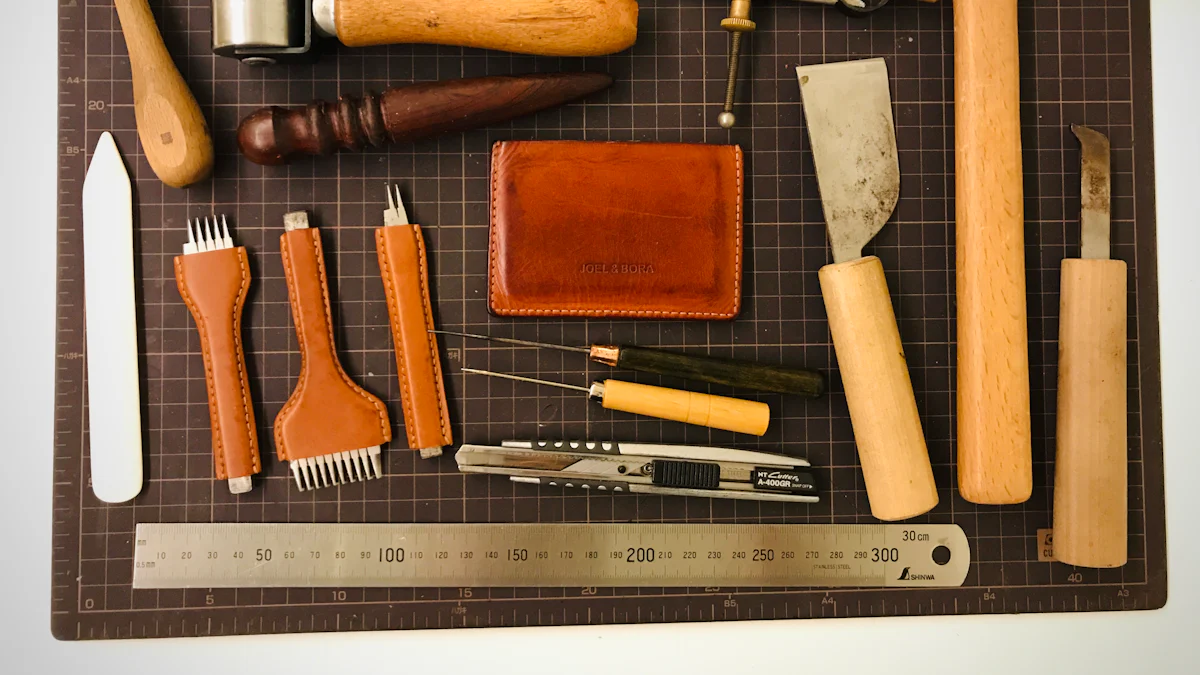
Hand cutting tools play a crucial role in various tasks, from woodworking to crafting. Selecting the right tool ensures precision and efficiency. The global household hand tools market, valued at USD 19.1 billion in 2023, is projected to reach USD 35.4 billion by 2032. North America leads this market, driven by DIY habits and social media influence. The Asia-Pacific region shows significant growth, with China experiencing a 6.3% increase in per capita disposable income in 2023. Understanding the importance of choosing the right hand cutting tools can enhance productivity and satisfaction.
Introduction to Hand Cutting Tools
Definition and Types
Hand cutting tools encompass a wide range of instruments designed for precise manual cutting. These tools serve various purposes across different industries and hobbies.
Knives
Knives are versatile hand cutting tools used in kitchens, workshops, and outdoor activities. The blade design varies based on the intended use, such as chef’s knives for cooking or utility knives for general tasks. High-carbon steel blades offer durability and sharpness, making them ideal for repeated use.
Saws
Saws are essential for woodworking and metalworking. Hand saws include types like crosscut saws, rip saws, and coping saws. Each type has a specific tooth pattern suited for different materials and cutting directions. For instance, crosscut saws excel at cutting across wood grain, while rip saws are designed for cutting along the grain.
Scissors
Scissors are common hand cutting tools found in homes, offices, and craft rooms. They consist of two pivoted blades that cut materials when the handles are squeezed together. Scissors vary in size and blade shape, catering to tasks like fabric cutting, paper crafting, and hair trimming.
Chisels
Chisels are primarily used in woodworking and masonry. These tools feature a sharp, beveled edge that carves or shapes materials. Wood chisels come in various widths and are often used with a mallet for detailed carving. Masonry chisels, made from hardened steel, can cut through stone and concrete.
Historical Background
The development of hand cutting tools has a rich history marked by innovation and adaptation.
Evolution of Hand Cutting Tools
Early humans used simple stone tools for cutting tasks. Over time, advancements in metallurgy led to the creation of bronze and iron tools. The Industrial Revolution brought significant changes, introducing mass production techniques and new materials like high-speed steel.
Key Innovations Over Time
Several key innovations have shaped modern hand cutting tools. The introduction of ergonomic designs has improved user comfort and efficiency. Studies on the ergonomics of pruning shears and shovels highlight the importance of design elements in usability and performance. Gender-specific operating strategies and user preferences have influenced tool design, ensuring better functionality for diverse users.
Benefits of Using Hand Cutting Tools
Precision and Control
Detailed Work
Hand cutting tools offer unparalleled precision for detailed tasks. Woodworkers can achieve intricate carvings with chisels. Crafters can create fine cuts in paper and fabric using specialized scissors. The manual control provided by hand tools ensures accuracy in every cut.
Customization
Hand cutting tools allow for extensive customization. Users can adjust the angle and pressure to suit specific needs. This flexibility makes hand tools ideal for bespoke projects. Custom knives and saws cater to unique cutting requirements in various materials.
Versatility
Various Materials
Hand cutting tools can handle a wide range of materials. Knives can cut through food, leather, and plastic. Saws can slice wood, metal, and even some types of stone. Scissors can trim fabric, paper, and thin metal sheets. This versatility makes hand tools indispensable in many fields.
Different Applications
Hand cutting tools serve multiple applications. Carpenters use saws for construction and furniture making. Chefs rely on knives for food preparation. Hobbyists use scissors and knives for crafting and model building. Each tool adapts to different tasks, enhancing its utility.
Cost-Effectiveness
Initial Investment
Hand cutting tools require a lower initial investment compared to power tools. Basic hand tools like knives and scissors are affordable. High-quality options may cost more but provide long-term value. The initial cost remains accessible for most users.
Maintenance Costs
Maintenance costs for hand cutting tools are minimal. Sharpening blades and oiling moving parts ensure longevity. Replacement parts are inexpensive and easy to find. Regular maintenance keeps tools in optimal condition without significant expense.
Hand cutting tools offer precision, versatility, and cost-effectiveness. These benefits make them essential for professionals and hobbyists alike.
Specific Uses of Hand Cutting Tools

Woodworking
Carving
Carving in woodworking requires precision and control. Woodworkers use chisels to create intricate designs and patterns. The sharp, beveled edges of chisels allow for detailed work on wood surfaces. Carvers often use mallets to apply controlled force, ensuring accuracy in each cut. High-carbon steel chisels provide durability and maintain sharpness, essential for repeated use.
Shaping
Shaping wood involves altering its form to achieve desired dimensions and contours. Hand saws play a crucial role in this process. Crosscut saws excel at cutting across the wood grain, while rip saws are ideal for cutting along the grain. Proper saw selection ensures clean cuts and reduces material waste. Woodworkers often use rasps and files to refine shapes, achieving smooth finishes on wooden surfaces.
Metalworking
Cutting
Cutting metal demands tools that can handle hard materials. Hacksaws are common hand tools used for this purpose. The fine-toothed blades of hacksaws make them suitable for cutting through metal pipes, rods, and sheets. High-speed steel blades enhance cutting efficiency and longevity. Metalworkers rely on precise blade tension to ensure straight cuts without bending or warping the material.
Trimming
Trimming metal involves removing excess material to achieve a clean finish. Tin snips are essential for this task. These hand tools feature sharp, serrated blades designed to cut through thin metal sheets. Metalworkers use tin snips to trim edges and create precise shapes. Proper grip and blade alignment ensure smooth, burr-free cuts, enhancing the quality of the finished product.
Crafting and Hobbies
Paper Cutting
Paper cutting is a popular activity in crafting and hobbies. Crafters use specialized scissors with fine, sharp blades for this purpose. Precision scissors allow for intricate cuts and detailed designs on paper. Rotary cutters offer an alternative, providing smooth, continuous cuts. Proper blade maintenance ensures clean edges and prevents tearing, essential for high-quality paper crafts.
Fabric Cutting
Fabric cutting requires tools that can handle various textiles. Tailor’s shears are the go-to hand tools for this task. These scissors feature long blades and ergonomic handles, providing comfort during extended use. Sharp blades ensure clean cuts through different fabrics, from delicate silk to heavy denim. Crafters often use rotary cutters for straight lines and curves, enhancing efficiency and accuracy in fabric projects.
Hand cutting tools serve specific purposes across different fields. Woodworkers, metalworkers, and crafters rely on these tools for precision and control. Proper tool selection and maintenance ensure optimal performance and longevity.
How to Choose the Right Hand Cutting Tool

Assessing Your Needs
Type of Material
Selecting the appropriate hand cutting tool begins with understanding the material you will cut. Different materials require specific tools for optimal performance. For instance, knives with high-carbon steel blades are ideal for cutting through food, leather, and plastic. Saws with varied tooth patterns excel in woodworking and metalworking tasks. Scissors cater to fabric, paper, and thin metal sheets. Chisels are perfect for wood and masonry work. Identifying the material ensures you choose a tool that delivers precision and efficiency.
Frequency of Use
The frequency of use plays a crucial role in selecting the right hand cutting tool. Frequent users should invest in durable, high-quality tools. Occasional users might opt for more budget-friendly options. High-carbon steel blades offer longevity for regular use. Ergonomic designs reduce fatigue during extended periods of use. Consider the tool’s durability and comfort to match your usage pattern.
Evaluating Quality
Blade Material
The blade material significantly impacts the tool’s performance and lifespan. High-carbon steel blades provide excellent sharpness and durability. Stainless steel blades resist corrosion, making them suitable for humid environments. Tungsten carbide blades offer superior hardness for cutting through tough materials. Evaluate the blade material to ensure it meets your cutting requirements.
Handle Comfort
Handle comfort is essential for efficient and safe tool use. Ergonomic handles with rubber padding minimize pressure on critical hand regions. This design improves muscle activity and grip force distribution. Thumb grips enhance control and reduce wrist deviations. Comfortable handles prevent hand fatigue and increase productivity. Prioritize tools with ergonomic designs for better user experience.
Budget Considerations
Price Range
Budget constraints influence the choice of hand cutting tools. Basic hand tools like box cutters and scissors are affordable. High-quality options may come at a higher price but offer long-term value. Determine your budget and explore tools within that range. Balance cost with quality to ensure you get the best tool for your needs.
Long-term Investment
Consider hand cutting tools as a long-term investment. Durable tools with high-quality materials provide better returns over time. Regular maintenance, such as sharpening blades and oiling moving parts, extends the tool’s lifespan. Investing in reliable tools reduces the need for frequent replacements. Evaluate the long-term benefits to make an informed decision.
Choosing the right hand cutting tool involves assessing your needs, evaluating quality, and considering your budget. Understanding these factors ensures you select a tool that delivers precision, comfort, and value.
Recapping the key points, hand cutting tools offer precision, versatility, and cost-effectiveness. Selecting the right tool enhances productivity and satisfaction in various tasks. The importance of choosing the correct hand cutting tool cannot be overstated.
“The quality and workmanship really show in the tools. Very impressed and will definitely be ordering more,” says Charlie about Kestrel tools.
Making informed decisions ensures optimal performance and longevity. High-quality tools provide better returns over time. Users should prioritize ergonomic designs and durable materials for the best results.
